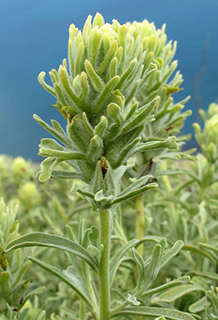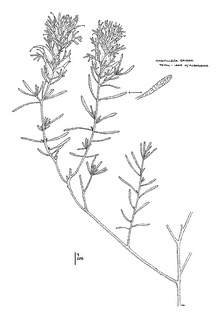(Castilleja grisea)
 Castilleja grisea. Photo © Dylan Neubauer.
Castilleja grisea. Photo © Dylan Neubauer.
 Castilleja grisea. CDFW illustration by Mary Ann Showers. (Click to enlarge)
Castilleja grisea. CDFW illustration by Mary Ann Showers. (Click to enlarge)
San Clemente Island paintbrush is a California endangered plant species, which means that killing or possessing the plant is prohibited by the California Endangered Species Act (CESA). The species is also listed as threatened under the federal Endangered Species Act. San Clemente Island paintbrush is a perennial subshrub found only on San Clemente Island. It is typically one to two feet tall and covered in dense wooly felt. Its flowers are green to yellow and bloom between February and April, and both hummingbird and insect pollination have been reported. San Clemente Island paintbrush is mostly found in steep rocky canyons on the island, but can also be found in coastal bluffs, slopes, and flats around the island’s perimeter. Like other species of the genus Castilleja,San Clemente Island paintbrush is hemiparasitic, which means that its roots tap the root system of other surrounding plant species to ensure that it receives adequate water and nutrients.
From 1850 to 1934, San Clemente Island was used for sheep and cattle ranching, goat grazing, and pig farming, and current habitat conditions were influenced by these intense land use practices. Feral goats and pigs were finally eradicated by 1992, and the vegetation and rare plant populations on the island have improved. It is difficult to tell how much these intense land use practices contributed to San Clemente Island paintbrush population declines because surveys for the plant were not completed prior to the start of these practices. San Clemente Island is now owned by the Navy, which carries out recovery actions for this and other listed species. According to the most recent U.S. Fish and Wildlife Five-Year Review (PDF) published in 2012, surveys for San Clemente Island paintbrush have found increased population numbers throughout its range. This could be due to increased survey efforts, recruitment from the seedbank, or a result of the Navy’s management actions. According to the California Natural Diversity Database, there are 35 occurrences of San Clemente Island paintbrush known to still exist, and three occurrences that have been extirpated.
Current threats to San Clemente Island paintbrush include habitat destruction caused by land use by the Navy, erosion, nonnative plant encroachment, fire, and fire management activities. The Navy implements erosion control, fire management, and nonnative species control plans to help lessen these threats. Military training could increase impacts to habitat as well, but a majority of San Clemente Island paintbrush occurrences fall outside of areas where intense disturbances occur. In order to ensure continued existence of San Clemente Island paintbrush, a systematic survey protocol should be developed to assess population trends, and studies on the preferred fire regime and fire tolerance should be conducted.
CDFW may issue permits for San Clemente Island paintbrush pursuant to CESA, and you can learn more about the California laws protecting San Clemente Island paintbrush and other California native plants. Populations of San Clemente Island paintbrush occur in CDFW’s South Coast Region. More information is also available from the U.S. Fish and Wildlife Service Species Profile for Castilleja grisea.
Updated 6/24/14